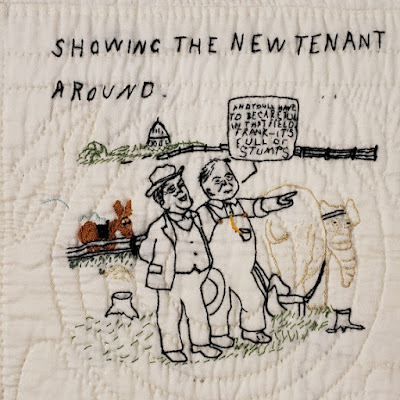Political commentary in an earlier election
The Johnson County Kansas Museum is showing this marvelous quilt from the early 1930s in an exhibit opening next week.
The 1932 election was between Herbert Hoover & Franklin D. Roosevelt,
quite recognizable here. Roosevelt won 42 states; Hoover 6.
She embroidered about 36 cartoons, alternating with blocks of plain fabric featuring a quilted wreath.
Democrat's donkey and Republican's elephant on Hoover's Washington farm.
A post-election sentiment.
Copied from a November 10, 1932 cartoon by the Star's
resident cartoonist Silvey J. Ray.
S.J. Ray (1891-1970) was Estella's collaborator.
Many quiltmakers looked to the Kansas City Star for inspiration but no one else checked the editorial page.
A similar political comment from the early 1930s:
Texan Fanny B. Shaw's Prosperity is Just Around the Corner
In the collection of the Dallas Museum of Art
The Johnson County Museum will be showing two dozen of their quilts in Common Threads opening November 7, up through January 23, 2021.I'll get over there in November and see if I can get more pictures.
And I am doing a virtual program for the museum in their History on Tap series: "Quilts on the Kansas Frontier" on November 12 at 6:00 Central Time. I think you have to bring your own beer this year.
Check their Facebook page for registration information.https://www.facebook.com/JocoMuseum/























































